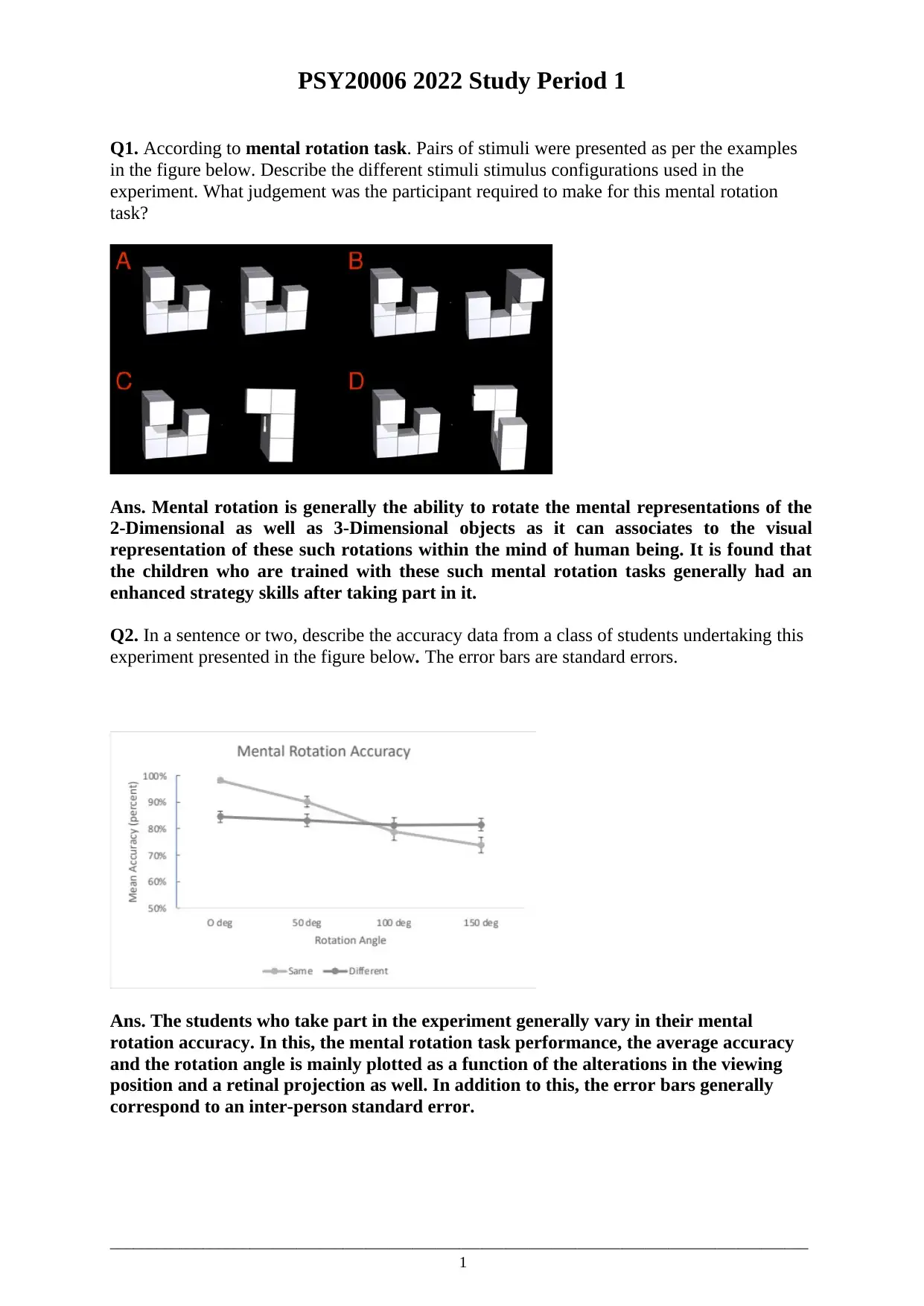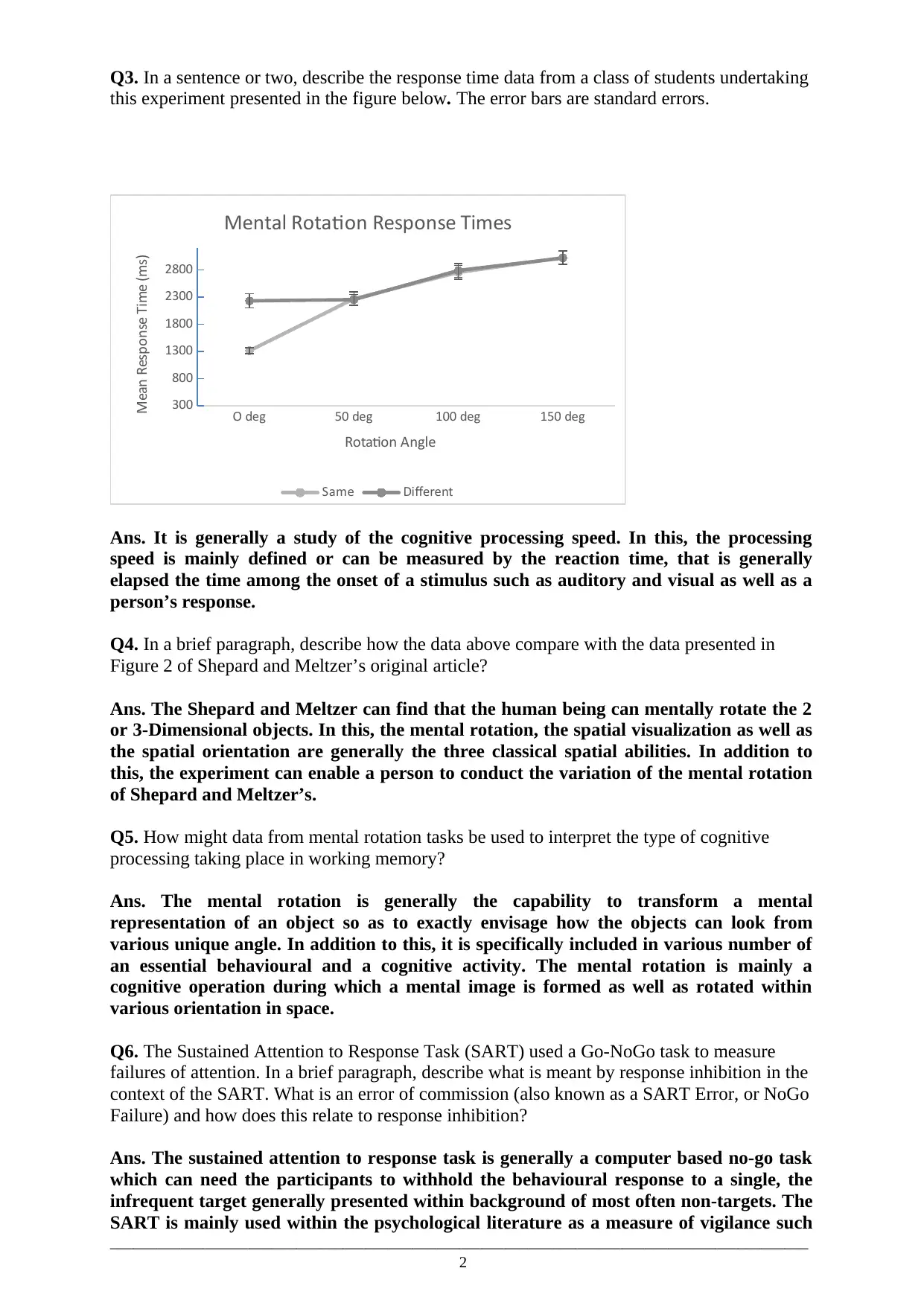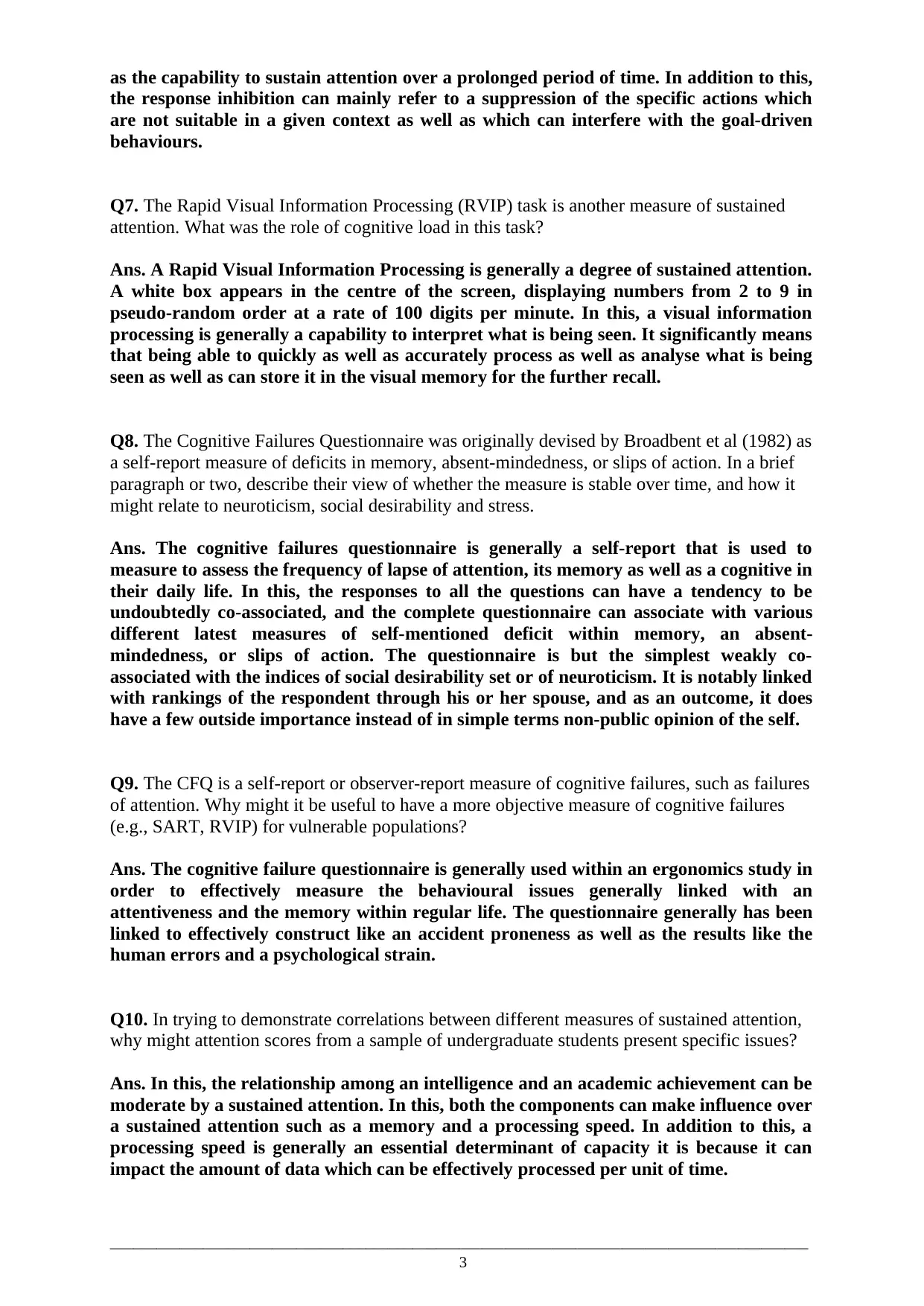PSY20006 Assignment 2: Analysis of Mental Rotation and Attention Tasks
VerifiedAdded on 2023/06/10
|3
|1261
|202
Homework Assignment
AI Summary
This assignment comprises answers to questions from a PSY20006 psychology course, focusing on mental rotation and sustained attention tasks. The questions cover the stimuli configurations and judgments required in mental rotation experiments, accuracy and response time data analysis, and comparisons with Shepard and Meltzer's original research. The assignment also explores how data from mental rotation tasks can be used to interpret cognitive processing within working memory. Furthermore, it addresses the Sustained Attention to Response Task (SART), defining response inhibition and errors of commission. The Rapid Visual Information Processing (RVIP) task and the role of cognitive load are discussed, along with the Cognitive Failures Questionnaire (CFQ) and its relation to cognitive deficits, neuroticism, and stress. The assignment considers the benefits of objective measures of cognitive failures for vulnerable populations and the issues that can arise from using undergraduate student samples in attention studies.

PSY20006 2022 Study Period 1
Q1. According to mental rotation task. Pairs of stimuli were presented as per the examples
in the figure below. Describe the different stimuli stimulus configurations used in the
experiment. What judgement was the participant required to make for this mental rotation
task?
Ans. Mental rotation is generally the ability to rotate the mental representations of the
2-Dimensional as well as 3-Dimensional objects as it can associates to the visual
representation of these such rotations within the mind of human being. It is found that
the children who are trained with these such mental rotation tasks generally had an
enhanced strategy skills after taking part in it.
Q2. In a sentence or two, describe the accuracy data from a class of students undertaking this
experiment presented in the figure below. The error bars are standard errors.
Ans. The students who take part in the experiment generally vary in their mental
rotation accuracy. In this, the mental rotation task performance, the average accuracy
and the rotation angle is mainly plotted as a function of the alterations in the viewing
position and a retinal projection as well. In addition to this, the error bars generally
correspond to an inter-person standard error.
__________________________________________________________________________________________
1
Q1. According to mental rotation task. Pairs of stimuli were presented as per the examples
in the figure below. Describe the different stimuli stimulus configurations used in the
experiment. What judgement was the participant required to make for this mental rotation
task?
Ans. Mental rotation is generally the ability to rotate the mental representations of the
2-Dimensional as well as 3-Dimensional objects as it can associates to the visual
representation of these such rotations within the mind of human being. It is found that
the children who are trained with these such mental rotation tasks generally had an
enhanced strategy skills after taking part in it.
Q2. In a sentence or two, describe the accuracy data from a class of students undertaking this
experiment presented in the figure below. The error bars are standard errors.
Ans. The students who take part in the experiment generally vary in their mental
rotation accuracy. In this, the mental rotation task performance, the average accuracy
and the rotation angle is mainly plotted as a function of the alterations in the viewing
position and a retinal projection as well. In addition to this, the error bars generally
correspond to an inter-person standard error.
__________________________________________________________________________________________
1
Paraphrase This Document
Need a fresh take? Get an instant paraphrase of this document with our AI Paraphraser

Q3. In a sentence or two, describe the response time data from a class of students undertaking
this experiment presented in the figure below. The error bars are standard errors.
O deg 50 deg 100 deg 150 deg
300
800
1300
1800
2300
2800
Mental Rotation Response Times
Same Different
Rotation Angle
Mean Response Time (ms)
Ans. It is generally a study of the cognitive processing speed. In this, the processing
speed is mainly defined or can be measured by the reaction time, that is generally
elapsed the time among the onset of a stimulus such as auditory and visual as well as a
person’s response.
Q4. In a brief paragraph, describe how the data above compare with the data presented in
Figure 2 of Shepard and Meltzer’s original article?
Ans. The Shepard and Meltzer can find that the human being can mentally rotate the 2
or 3-Dimensional objects. In this, the mental rotation, the spatial visualization as well as
the spatial orientation are generally the three classical spatial abilities. In addition to
this, the experiment can enable a person to conduct the variation of the mental rotation
of Shepard and Meltzer’s.
Q5. How might data from mental rotation tasks be used to interpret the type of cognitive
processing taking place in working memory?
Ans. The mental rotation is generally the capability to transform a mental
representation of an object so as to exactly envisage how the objects can look from
various unique angle. In addition to this, it is specifically included in various number of
an essential behavioural and a cognitive activity. The mental rotation is mainly a
cognitive operation during which a mental image is formed as well as rotated within
various orientation in space.
Q6. The Sustained Attention to Response Task (SART) used a Go-NoGo task to measure
failures of attention. In a brief paragraph, describe what is meant by response inhibition in the
context of the SART. What is an error of commission (also known as a SART Error, or NoGo
Failure) and how does this relate to response inhibition?
Ans. The sustained attention to response task is generally a computer based no-go task
which can need the participants to withhold the behavioural response to a single, the
infrequent target generally presented within background of most often non-targets. The
SART is mainly used within the psychological literature as a measure of vigilance such
__________________________________________________________________________________________
2
this experiment presented in the figure below. The error bars are standard errors.
O deg 50 deg 100 deg 150 deg
300
800
1300
1800
2300
2800
Mental Rotation Response Times
Same Different
Rotation Angle
Mean Response Time (ms)
Ans. It is generally a study of the cognitive processing speed. In this, the processing
speed is mainly defined or can be measured by the reaction time, that is generally
elapsed the time among the onset of a stimulus such as auditory and visual as well as a
person’s response.
Q4. In a brief paragraph, describe how the data above compare with the data presented in
Figure 2 of Shepard and Meltzer’s original article?
Ans. The Shepard and Meltzer can find that the human being can mentally rotate the 2
or 3-Dimensional objects. In this, the mental rotation, the spatial visualization as well as
the spatial orientation are generally the three classical spatial abilities. In addition to
this, the experiment can enable a person to conduct the variation of the mental rotation
of Shepard and Meltzer’s.
Q5. How might data from mental rotation tasks be used to interpret the type of cognitive
processing taking place in working memory?
Ans. The mental rotation is generally the capability to transform a mental
representation of an object so as to exactly envisage how the objects can look from
various unique angle. In addition to this, it is specifically included in various number of
an essential behavioural and a cognitive activity. The mental rotation is mainly a
cognitive operation during which a mental image is formed as well as rotated within
various orientation in space.
Q6. The Sustained Attention to Response Task (SART) used a Go-NoGo task to measure
failures of attention. In a brief paragraph, describe what is meant by response inhibition in the
context of the SART. What is an error of commission (also known as a SART Error, or NoGo
Failure) and how does this relate to response inhibition?
Ans. The sustained attention to response task is generally a computer based no-go task
which can need the participants to withhold the behavioural response to a single, the
infrequent target generally presented within background of most often non-targets. The
SART is mainly used within the psychological literature as a measure of vigilance such
__________________________________________________________________________________________
2

as the capability to sustain attention over a prolonged period of time. In addition to this,
the response inhibition can mainly refer to a suppression of the specific actions which
are not suitable in a given context as well as which can interfere with the goal-driven
behaviours.
Q7. The Rapid Visual Information Processing (RVIP) task is another measure of sustained
attention. What was the role of cognitive load in this task?
Ans. A Rapid Visual Information Processing is generally a degree of sustained attention.
A white box appears in the centre of the screen, displaying numbers from 2 to 9 in
pseudo-random order at a rate of 100 digits per minute. In this, a visual information
processing is generally a capability to interpret what is being seen. It significantly means
that being able to quickly as well as accurately process as well as analyse what is being
seen as well as can store it in the visual memory for the further recall.
Q8. The Cognitive Failures Questionnaire was originally devised by Broadbent et al (1982) as
a self-report measure of deficits in memory, absent-mindedness, or slips of action. In a brief
paragraph or two, describe their view of whether the measure is stable over time, and how it
might relate to neuroticism, social desirability and stress.
Ans. The cognitive failures questionnaire is generally a self-report that is used to
measure to assess the frequency of lapse of attention, its memory as well as a cognitive in
their daily life. In this, the responses to all the questions can have a tendency to be
undoubtedly co-associated, and the complete questionnaire can associate with various
different latest measures of self-mentioned deficit within memory, an absent-
mindedness, or slips of action. The questionnaire is but the simplest weakly co-
associated with the indices of social desirability set or of neuroticism. It is notably linked
with rankings of the respondent through his or her spouse, and as an outcome, it does
have a few outside importance instead of in simple terms non-public opinion of the self.
Q9. The CFQ is a self-report or observer-report measure of cognitive failures, such as failures
of attention. Why might it be useful to have a more objective measure of cognitive failures
(e.g., SART, RVIP) for vulnerable populations?
Ans. The cognitive failure questionnaire is generally used within an ergonomics study in
order to effectively measure the behavioural issues generally linked with an
attentiveness and the memory within regular life. The questionnaire generally has been
linked to effectively construct like an accident proneness as well as the results like the
human errors and a psychological strain.
Q10. In trying to demonstrate correlations between different measures of sustained attention,
why might attention scores from a sample of undergraduate students present specific issues?
Ans. In this, the relationship among an intelligence and an academic achievement can be
moderate by a sustained attention. In this, both the components can make influence over
a sustained attention such as a memory and a processing speed. In addition to this, a
processing speed is generally an essential determinant of capacity it is because it can
impact the amount of data which can be effectively processed per unit of time.
__________________________________________________________________________________________
3
the response inhibition can mainly refer to a suppression of the specific actions which
are not suitable in a given context as well as which can interfere with the goal-driven
behaviours.
Q7. The Rapid Visual Information Processing (RVIP) task is another measure of sustained
attention. What was the role of cognitive load in this task?
Ans. A Rapid Visual Information Processing is generally a degree of sustained attention.
A white box appears in the centre of the screen, displaying numbers from 2 to 9 in
pseudo-random order at a rate of 100 digits per minute. In this, a visual information
processing is generally a capability to interpret what is being seen. It significantly means
that being able to quickly as well as accurately process as well as analyse what is being
seen as well as can store it in the visual memory for the further recall.
Q8. The Cognitive Failures Questionnaire was originally devised by Broadbent et al (1982) as
a self-report measure of deficits in memory, absent-mindedness, or slips of action. In a brief
paragraph or two, describe their view of whether the measure is stable over time, and how it
might relate to neuroticism, social desirability and stress.
Ans. The cognitive failures questionnaire is generally a self-report that is used to
measure to assess the frequency of lapse of attention, its memory as well as a cognitive in
their daily life. In this, the responses to all the questions can have a tendency to be
undoubtedly co-associated, and the complete questionnaire can associate with various
different latest measures of self-mentioned deficit within memory, an absent-
mindedness, or slips of action. The questionnaire is but the simplest weakly co-
associated with the indices of social desirability set or of neuroticism. It is notably linked
with rankings of the respondent through his or her spouse, and as an outcome, it does
have a few outside importance instead of in simple terms non-public opinion of the self.
Q9. The CFQ is a self-report or observer-report measure of cognitive failures, such as failures
of attention. Why might it be useful to have a more objective measure of cognitive failures
(e.g., SART, RVIP) for vulnerable populations?
Ans. The cognitive failure questionnaire is generally used within an ergonomics study in
order to effectively measure the behavioural issues generally linked with an
attentiveness and the memory within regular life. The questionnaire generally has been
linked to effectively construct like an accident proneness as well as the results like the
human errors and a psychological strain.
Q10. In trying to demonstrate correlations between different measures of sustained attention,
why might attention scores from a sample of undergraduate students present specific issues?
Ans. In this, the relationship among an intelligence and an academic achievement can be
moderate by a sustained attention. In this, both the components can make influence over
a sustained attention such as a memory and a processing speed. In addition to this, a
processing speed is generally an essential determinant of capacity it is because it can
impact the amount of data which can be effectively processed per unit of time.
__________________________________________________________________________________________
3
⊘ This is a preview!⊘
Do you want full access?
Subscribe today to unlock all pages.

Trusted by 1+ million students worldwide
1 out of 3
Your All-in-One AI-Powered Toolkit for Academic Success.
+13062052269
info@desklib.com
Available 24*7 on WhatsApp / Email
![[object Object]](/_next/static/media/star-bottom.7253800d.svg)
Unlock your academic potential
Copyright © 2020–2025 A2Z Services. All Rights Reserved. Developed and managed by ZUCOL.